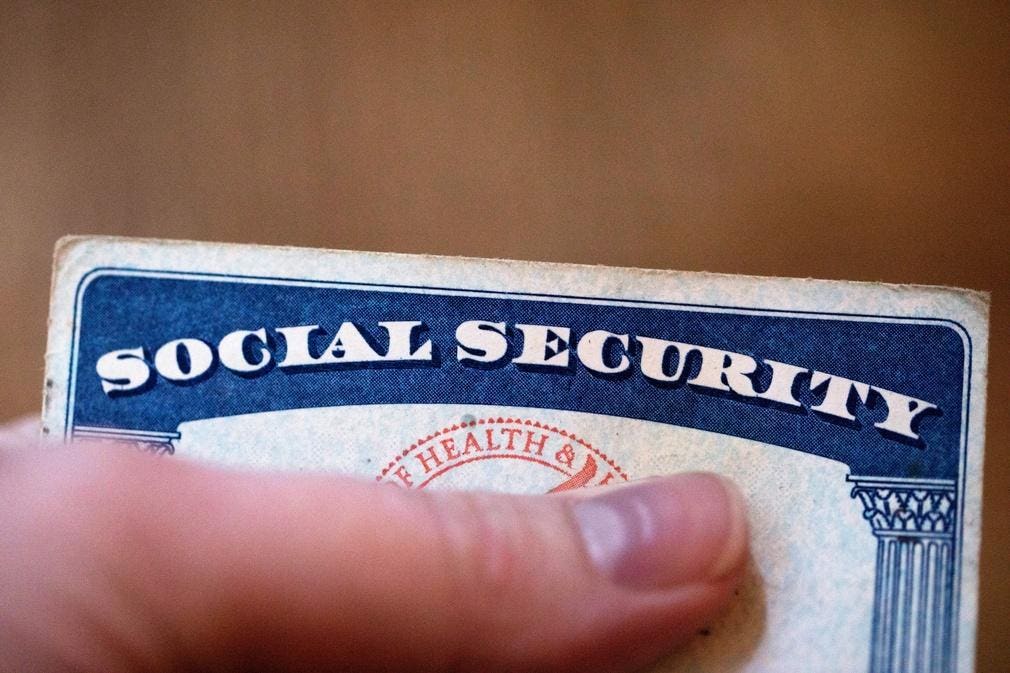FILE – A Social Security card is displayed on Oct. 12, 2021, in Tigard, Ore. The go-broke dates for … More
Social Security continues to be in trouble. Pundits and congressional representatives often argue at length about what needs to be done to keep an important safety net that has repeatedly proven its value by reducing poverty. Suggestions include raising the retirement age and cutting benefits.
No need to worry about the latter as that will happen automatically in 2033. And yet, it doesn’t need to, as there’s a straightforward solution to the problem. It’s just one that people in Congress seem to dislike.
The Growing Problem
The recent The 2025 Annual Report of the Board of Trustees of the Federal Old-Age and Survivors Insurance and Federal Disability Insurance Trust Funds — called the 2025 OASDI Trustees Report for short — had, as has become usual, more sobering news about Social Security.
Using current assumptions, the cost of the two funds “exceeds total income in every year of the long-range period, which runs from 2025 through 2099.” By 2033, the OSAI reserves will be exhausted, triggering an automatic cut of 23%. Every older retired person you know who has eked out living expenses from Social Security will find themselves losing almost a quarter of their income. (The Disability Insurance Trust Fund wouldn’t be depleted and so doesn’t face the same deadline.)
Backfilling the program will be difficult. First, the United States continues to bet on borrowing money to pay its bills by selling Treasury notes and bonds. These instruments have a price that one pays to provide a loan, and a yield — the interest paid on the money the country borrows. Social Security.
On secondary markets, the price and yield move inversely. The higher the yield, the lower the price, meaning there’s less demand, which has increasingly been the case. Borrowing money through selling Treasury instruments means paying higher interest rates, increasing the national debt. Service on that debt is already more than a trillion dollars a year. That’s already more than the annual Department of Defense budget and will continue to grow.
A General Fix
The typical discussion about fixing the retirement fund is that the shortfall is due to an aging population. That frequently gets people upset because they say they paid into the system and should get everything back. That’s not how Social Security works. It was never a personal savings account.
Instead, it’s more like insurance. People pay into the system over the long haul, with the collected funds used to cover payouts when necessary. Like insurance premiums, the regular payment of Social Security-related taxes aren’t yours. They go into keeping the system going.
According to the Peter G. Peterson Foundation, to set things right, either an immediate 29% increase in payroll taxes or a 22% cut in benefits would be necessary to set things straight. Or some combination of the two. Wait to start until 2034 and it would require a 34% increase in payroll taxes, or 26% benefits cut. That’s points to the power of compound interest.
A Different Twist On Taxes
When considering taxes, the expectation is that everyone’s payroll taxes should go up. But according to a long-standing view of the Social Security Administration’s Chief Actuary Stephen Goss, there is a slightly different take.
The big problem has been rising income inequality, particularly between 1983 and 2000. The best-paid 6% of people saw their incomes rise by 62% in inflation-adjusted terms. The other 94% saw their incomes increase by only 17%. The large portion of income gains of the top 6% were above the maximum taxable income level. They got out of paying the same percentage of their incomes into the system that everyone else paid.
There is also the compounding factor that, for many years, the Federal Reserve kept interest rates low, meaning yields of Treasury instruments fell and Social Security, which is required by law to invest only in these, made a lot less investment income.
One possibility is to remove the cap from payroll taxes and let the wealthiest pay the same percentage of their income as everyone else. Even though that won’t immediately make up for the 17-year period of sharp growth, it would help bring in more revenue.
Read the full article here
